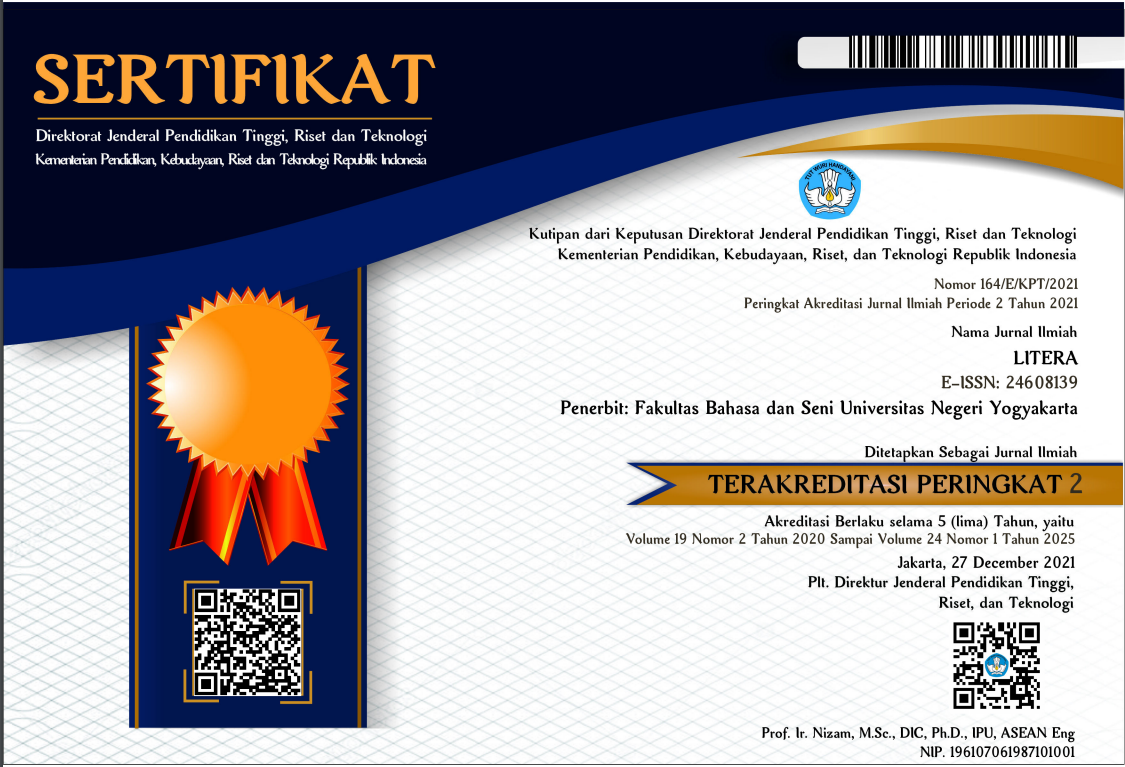LAMPUNG CLAUSE COMPLEXES: A PARATACTIC CONFIGURATION STUDY
Farida Ariyani, Universitas Lampung, Indonesia
Ingatan Gulo, Universitas Teknokrat Indonesia, Indonesia
Abstract
Keywords
Full Text:
PDFReferences
Atkinson, Paul and Coffey, Amanda. 2004. Analysing documentary realities. In: David Silverman, Qualitative research: theory, method, and practice. London: Sage Publications, pp. 56-75.
Barrett, Grant. 2016. Perfect English Grammar: the Indispensable Guide to Excellent Writing and Speaking. California: Zephyrus Press.
Berry, Roger, 2015. From Words to Grammar: Discovering English Usage. London and New York: Routledge.
Börjars, Kersti and Burridge, Kate. 2010. Introducing English grammar (2nd ed). London: Hodder Education.
Carter, Ronald and McCarthy, Michael. 2006. Cambridge grammar of English. UK: Cambridge University Press.
Creswell, John W. 2014. Research Design: Quantitative, Qualitative, dan Mixed Method. California: Sage Publication Inc.
Croker, Robert A. 2009. An introduction to qualitative research. In: Heigham, Juanita & Croker, Robert A. (eds.), Qualitative research in applied linguistics: a practical introduction. London: Palgrave Mcmillan, pp. 3-24.
Delahunty, Gerald P. and Garvey, James J. 2010. The English Language from Sound to Sense. Colorado: The WAC Clearing House.
Ethnologue – Languages of the world. 2020. A language of Indonesia. [Accessed 26 September 2020]. Available at: https:// www.ethnologue.com/language/ljp
Fontaine, Lise. 2013. Analyzing English Grammar: a Systemic Functional Introduction. New York: Cambridge University Press.
Halliday, M.A.K., & Matthiessen, Christian M.I.M. 2014. Halliday’s Introduction to Functional Grammar (4th ed.). London: Edward Arnold.
Hinton, Leanne. 2011Revitalization of endangered language. In Peter K. Austin and Julia Sallabank, eds, The Cambridge Handbook of Endangered Languages. Cambridge: Cambridge University Press.
Moseley, Christopher (ed.). 2010. Atlas of the World’s Languages in Danger, (3rd ed). Paris: UNESCO Publishing. (http://www.unesco.org/culture/en/endangeredlanguages/atlas)
Satun, Aidy Ruslan, Arif R.M., Lamsari, Kasmansyah, and Erhamma. 1985. Struktur bahasa Lampung. Jakarta: Pusat Pembinaan dan Pengembangan Bahasa, Departemen Pendidikan dan Kebudayaan.
Silverman, David. 2015. Interpreting qualitative data. London: Sage Publication Ltd.
Stake, Robert E. 2010. Qualitative research - studying how things work. New York: The Guilford Press.
Thompson, Geoff. (2014). Introducing functional grammar. London and New York: Routledge.
Udin, Nazaruddin; Sudrajat, R; Akhyar, Wardinah; Rejono, Imam; Sanusi, Efendi. 1992. Tata bahasa bahasa Lampung dialek Pesisir. Jakarta: Pusat Pembinaan dan Pengembangan Bahasa, Departemen Pendidikan dan Kebudayaan.
Walker. Dale F. 1976. A Grammar of Lampung Language: the Pesisir Dialect of Way Lima. Jakarta: Badan Penyelenggara Seri Nusa.
Wety, Nyoman. 1992. Struktur Bahasa Lampung Dialek Abung. Jakarta: Departemen Pendidikan dan Kebudayaan.
DOI: https://doi.org/10.21831/ltr.v20i3.37064
Refbacks
- There are currently no refbacks.
______________________
__________________________________________________________________________________________________
Litera Journal is published by the Faculty of Languages, Arts, and Culture Universitas Negeri Yogyakarta in collaboration with Himpunan Sarjana Kesusasteraan Indonesia (HISKI)
The International Journal of Linguistic, Literature, and Its Teaching at http://http://journal.uny.ac.id/index.php/litera/ is licensed under a Creative Commons Attribution-ShareAlike 4.0 International License
__________________________________________________________________________________________________















